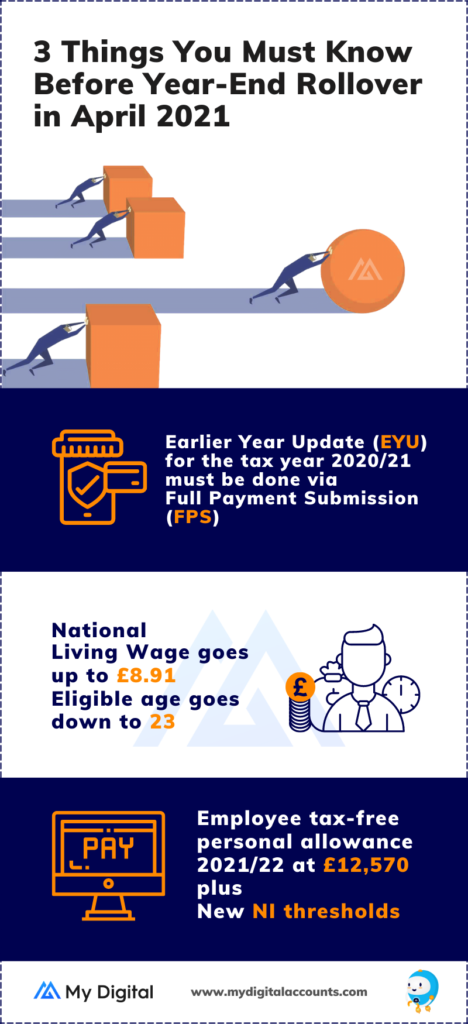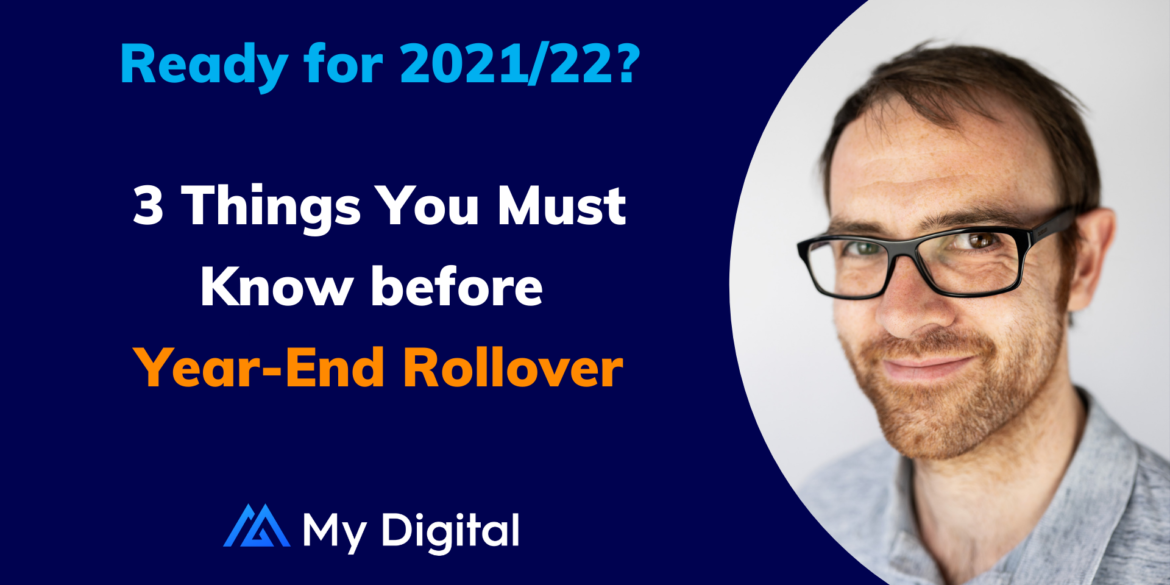3 Things You Must Know Before Year-End Rollover in April 2021
Whether you’re an accounting provider or umbrella company, the end of the 2020/21 fiscal year will bring several legislative changes that will matter to your business. You’ll need to implement these changes in partnership with your payroll software provider and, since we are in the same boat, the team at My Digital has put together an essential guide with the most important changes impacting Year-End Rollover.
Don’t have time to read now? Watch a quick overview video (running time just 1:30min)
Otherwise… buckle up, read on and get ahead of 2021/2022
1. Earlier Year Update (EYU) via Full Payment Submission (FPS) in 2021
What’s going on here?
Historically, if you reported the wrong pay or deductions in 2018/19 or 2019/20 tax years, you’ve been able to correct this by submitting an Earlier Year Update (EYU) or a further Full Payment Submission (FPS) with the correct year to date figures. Not all software systems had the ability to submit EYUs and the HMRC basic tool has been the main method of submitting these updates. Well… this is about to change.
What does this mean?
As of April, EYUs for the tax year 2020/21 must all be done using FPS submissions. This means that payroll software suppliers must have solutions in place for payroll professionals to submit corrections via their software and meet the requirements of Year-End Rollover.
Why should I care?
Simply put, starting on April 2021, these payroll corrections will have to be done in line with the new requirements and you’ll need to make sure your software will do what you need it to do.
We get it! That’s the reason My Digital is updating its FPS mechanism. In April, EYU submissions will be just a few clicks away and you’ll be welcoming springtime with a big smile on your face.
2. National Living Wage goes up, eligible age goes down
What’s going on here?
The biggest change coming into effect in April 2021 is the lowering of the National Living Wage age.
What does this mean?
Previously anyone over the age of 25 would receive the National Living Wage as a minimum, this will now be anyone over the age of 23. Apart from the anticipated increase in hourly rates, in 2021/22 every employer will have to pay a minimum of £8.91 to every employee aged 23 and over.
Why should I care?
If you have vigorous and ambitious people in their 20s on your payroll, you’ll want to make sure you comply with the new legislation and that everyone is paid correctly.
My Digital will give you the choice of setting when the National Living Wage table comes into effect within the software. This is so if you’re paying people in arrears, it doesn’t automatically change the rates until you’re ready. We made it that simple.
| Category of Worker | Hourly Rate from 1st April 2021 |
| Aged 23 and Above (National Living Wage Rate) | £8.91 |
| Aged 21 to 22 inclusive | £8.36 |
| Aged 18 to 20 inclusive | £6.56 |
| Aged under 18 (but above compulsory school leaving age) | £4.62 |
| Apprentices aged under 19 | £4.30 |
| Apprentices aged 19 and over but in the first year of their apprenticeship | £4.30 |
3. New payroll rates and thresholds on Year-End Rollover
What’s going on here?
This will come as no surprise. Year after year, the payroll rates and thresholds gradually increase in the UK and this upcoming year is no different.
What does this mean?
For the majority, it’s good news – the employee personal allowance is going up. There’s an extra £70 tax-free, increasing the total to £12,570 per year.
National Insurance thresholds are also changing, with the Primary threshold increasing. All of this means that Britons will see some benefits to their net wages.
Why should I care?
For payroll professionals and the software systems that calculate UK payroll, these changes mean plenty of preparation is needed to make sure that everything is tuned to the 2021/22 tax year. If you work in payroll, make sure you get familiar with what’s coming and your software provider should help you transition to these new thresholds with ease.
Summary of changes
| Class 1 National Insurance Thresholds | 2020/21 tax year (Per Year thresholds) | New 2021/20 tax year (Per Year thresholds) |
| Lower Earnings Limit | £6,240 | £6,240 |
| Primary Threshold | £9,500 | £9,568 |
| Secondary Threshold | £8,788 | £8,840 |
| Upper Secondary Threshold (under 21) | £50,000 | £50,270 |
| Apprentice Upper Secondary Threshold (Apprentice under 25) | £50,000 | £50,270 |
| Upper Earnings Limit | £50,000 | £50,270 |
Facts to remember about the YERO changes

